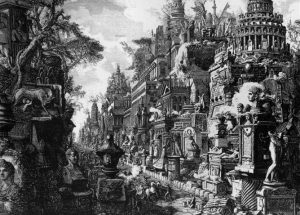The Grand Tour in Italy
Beginning late in the 17th century, long before travelers came to be known as tourists, foreigners began making what was later called The Grand Tour of Europe. In the beginning, The Grand Tour represented a kind of finishing school for young men of means, primarily among the British upper crust. It was how one learned to become a gentleman, setting the stage for a leadership role. To be educated was to be cultured, making the Grand Tour a mark of attainment in one’s classical education. The Grand Tour familiarized these travelers with the great works of art and architecture from ancient times through the Renaissance.
The Grand Tour was the ultimate in luxury travel, with servants to handle the luggage and scholarly tutors to provide education and insights on a vast array of topics. The earliest of grand tour itineraries included a stay in Paris, travel through Italy, usually only as far south as Rome, and some time in Germany.

Souvenir of The Grand Tour: “Ancient Intersection of Via Appia and Via Ardeatina,” etching by Giovanni Battista Piranesi, 1756
The accounts of some grand tourists became literary classics including two volumes by Scottish writer James Boswell and the Italian journeys of Johann Wolfgang Goethe, though Goethe waited until age thirty-eight to embark and set out from Weimar, not London.
The original Grand Tour was a long, leisurely trip, lasting weeks and sometimes months or years. Until the Age of Enlightenment when the idea of public museums took hold, the great works of art resided mostly in the homes of aristocrats. Without the aid of telephone, email or fax, organizing such excursions was a feat in itself! Then of course there were the logistics of transport in horse-drawn carriages and sailing vessels. Once rail lines began connecting the major cities of Europe, the speed, cost and efficiency of this new mode of transportation put The Grand Tour within reach of the middle class and eventually Americans.
With modern air travel, The Grand Tour has become shorter still. Nonetheless, this trip of a lifetime is as popular as ever, especially among mature travelers who think of such experiences as part of a larger bucket list of places and events. For many a traveler, getting to the great cultural destinations of the Western world is a component of a life well-lived.
While guidebooks have made possible a self-directed version of The Grand Tour, such publications are no substitute for being escorted by knowledgeable guides steeped in cultural history. The Grand Tours we offer are meticulously planned for modest-sized private groups. We match culturally-rich itineraries with a wide choice of European and U.S. destinations, combined with first class lodgings and memorable cuisine. Because of our longstanding relationships and years of experience in the cultural travel business, we are able to obtain highly sought-after tickets to important arts events, gain access to private collections and have the know-how to eliminate the hassle of travel. Our itineraries also offer plenty of leisure time for contemplation, making our trips ideal for the independent- minded traveler, unaccustomed to group travel. The Grand Tour isn’t one of our specialties. It is our raison d’etre.
